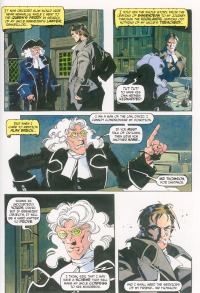| ________________
CM . . .
. Volume XIV Number 2 . . . . September 14, 2007
This graphic novel version of the Robert Louis Stevenson classic follows the broad outlines of the well-known plot: 17-year-old orphan David Balfour is kidnapped for slavery in America in a plot by his uncle Ebenezer to cheat him out of his inheritance. When the slave ship sinks, David and fellow survivor, the Scottish rebel Alan Breck, embark on a desperate journey to escape the English authorities after Breck murders a Scottish collaborator. When they finally reach Edinburgh, David and Alan orchestrate a confession by Ebenezer who then agrees to grant David a share of the estate and to arrange for Alan's escape by sea, nonetheless leaving David a tortured and unsettled soul.
Graphic fiction, a medium that is just now starting to attain a maturity and an acceptance that it has never before enjoyed, is well served by adaptations of classics which can often find new audiences that might just be excited by the story. Kidnapped is a great choice in this regard as it has long been a classic that is as popular as it is literate, not to mention its intrinsic appeal to boys. This version manages to pare down Stevenson's prose to narration and dialogue that still retains the period's flavour and the novel's drama, although the more exotic of Alan's Scots usage is rarely seen. What it removes in terms of prose - characterization, description, emotion - it does very well at adding in through the technique of facial close-ups that graphic novels have so well developed, an almost film-like multiple perspective that conveys a depth that rivals some of the best prose, with nary a hint of pretension or awkwardness. The only serious criticism I have of this version is that it leaves out a critical detail that leaves the reader unfamiliar with the original completely baffled by the last frame. In the book, Balfour's lawyer not only arranges for his inheritance and Alan's safe passage, but also for a measure of protection, through his bank, for guilt-ridden David if he wishes to confess his accessory to the murder. The final scene, in both versions, is of David finding himself led by "Providence" to that same bank, foreshadowing a confession that Stevenson alludes to in his afterword. In the adaptation, the reader has never heard of the bank and has no idea how it is related to David's gnawing guilt! Nonetheless, while no comparison to the original is fair - a graphic adaptation is not an attempt to match the originality of Stevenson's prose - what can be said is that this is an excellent attempt at bringing a classic to a new audience, and one that uses the best of the medium to convey meaning in a new way. Recommended. Todd Kyle is a former President of the Canadian Association of Children's Librarians who is currently a library branch manager in Mississauga, ON.
To comment on this
title or this review, send mail to cm@umanitoba.ca.
Copyright © the Manitoba Library Association. Reproduction for personal
use is permitted only if this copyright notice is maintained. Any
other reproduction is prohibited without permission.
NEXT REVIEW |TABLE OF CONTENTS FOR THIS ISSUE
- September 14, 2007. AUTHORS
| TITLES | MEDIA REVIEWS
| PROFILES
| BACK ISSUES
| SEARCH | CMARCHIVE
| HOME |

